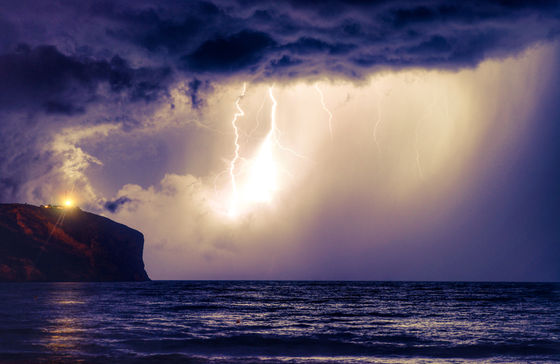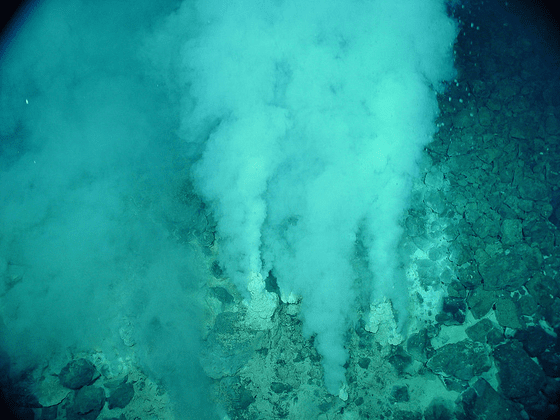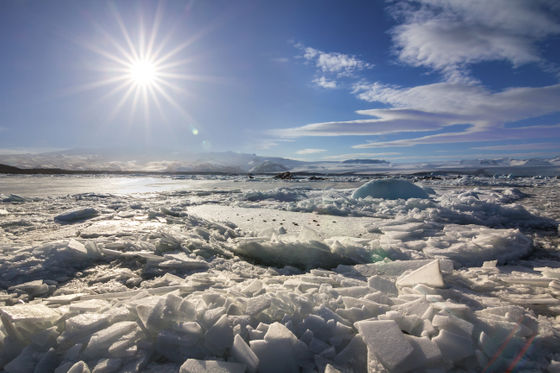Seven theories about 'the origin of life'

For humankind, how the first life of the earth appeared is one of the eternal themes, and there are 123 theories about
7 Theories on the Origin of Life | Live Science
https://www.livescience.com/13363-7-theories-origin-life.html
◆ 1: The origin of life was born from lightning
American chemists Stanley Miller and Harold Urey have described the source of life by lightning strikes from an experiment in which water, methane, ammonia, and hydrogen that reproduce the primitive earth are sealed and discharged in a sealed experimental device. Announced that the amino acid was synthesized. This famous experiment, called the ' Miller-Urey experiment, ' is positioned as an early experiment in the theory of chemical evolution , in which simple molecules were made into complex molecules that eventually evolved into life.
Later, it became clear that the primordial Earth's atmosphere had less hydrogen than Miller et al. Expected, but researchers at NASA and the University of California, San Diego wrote in a 2008 paper , 'Volcanic. The clouds created by the eruption contained methane, ammonia, and hydrogen, and it is possible that lightning was also occurring. '

◆ 2: The first life was born in the mud
Alexander Graham Cairns-Smith, an organic chemist at the University of Glasgow, Scotland, wrote in his 1985 book, '
The main role of DNA is to store information that dictates how the amino acid molecules of the proteins that make up the body are arranged. According to Cairns-Smith's hypothesis, the origin of life is that the crystals of minerals contained in clay organize organic molecules, which later become organized by themselves. This ambitious theory was controversial among biologists in the 1980s, but it seems that it is not widely accepted by the modern scientific community.
◆ 3: Life was born from hot water that springs from the bottom of the sea
In a paper published in the journal Nature Reviews Microbiology in 2008, a research team led by William Martin, a researcher at Heinrich Heine University in Dusseldorf, Germany, described elements ejected from deep-sea hydrothermal vents . He proposed the 'hydrothermal vent theory' that the first life was born from.
Hydrothermal vents, where geothermally heated water spouts from the bottom of the sea, contain substances and minerals such as carbon and hydrogen that are taken in as they pass through the crust. The hydrothermal vent theory is that these molecules gather in the gaps between rocks and provide an important catalyst for the birth of life.

by
In a study published by researchers at the University of London in 2019, they succeeded in creating a protocell that is the predecessor of primitive cells in the same high temperature and alkaline environment as a hydrothermal vent.
◆ 4: Life was born in the ice
The birth of life requires organic compounds, which are present in very low concentrations in water and are chemically unstable and quickly destroyed. Therefore, some researchers think that 'the freezing of water and the concentration of molecules such as amino acids may have promoted the birth of the first life.'
Jeffrey Bada, a marine chemist at the University of California, conducted an experiment in which a diluted solution of ammonium cyanide, an inorganic compound, was frozen at low temperature for 25 years in order to investigate the behavior of molecules in ice-covered stars such as Europa. I did it. As a result, it was obtained that substances important for life such as adenine and guanine that compose DNA are produced.
'Organic compounds that are important to the origin of life become more stable in cold environments,' Bada said. According to this theory, ice also played a role in protecting organic compounds from cosmic rays that are dangerous to life such as ultraviolet rays.

◆ 5: Life started with RNA, which is simpler than DNA
The proteins that make up the body of life are synthesized based on the information in DNA, but proteins are also required for DNA synthesis. Therefore, it is a difficult problem how life was born on the primitive earth without DNA and protein. The proposal was made in the RNA world , 'Isn't RNA that stores information like DNA, acts as an enzyme like protein, and is involved in the synthesis of both DNA and protein?' It's a hypothesis .
◆ 6: Started with a simpler molecule
The RNA world hypothesis leaves us wondering how the first RNA was born in the first place. Therefore, it was hypothesized that small molecules interacted with each other, and that what was contained in a bubble capsule like a cell membrane became complicated and became a life. This idea is called the 'metabolism priority model' as opposed to the 'gene priority model' of the RNA world hypothesis.
◆ 7: The first life came from space
Japan's Tanpopo Project , which investigates whether microorganisms can survive outside the International Space Station (ISS), has confirmed that they can survive even if they are exposed to ultraviolet rays in outer space for three years.
It turns out that microorganisms can survive for a long time even in outer space, and is it a strong basis for the theory that 'life came from space'?

This experiment, which shows that microorganisms can survive in outer space for decades in some cases, is said to be more influential in the Panspermia theory that the first life on Earth came from space on asteroids and the like. increase. However, if the Panspermia theory is correct, a new mystery will be born: 'How was life before coming to Earth?'
Related Posts:






